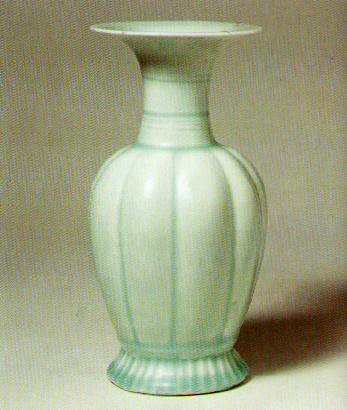
Song Dynasty celadon vase, Porcelain
China, 1100 CE, 10.25" height
ART 198 - HISTORY OF WORLD CERAMICS
| The Song Dynasty represents an artistic zenith in the history of ceramics. The court pottery of this period is as elegant as any ever made. While porcelain had been developed earlier, it was during the Song Dynasty that it was perfected, along with a development of glazes unsurpassed to this day. A desire to produce glazes that resembled the highly valued jade, led to experimentation with what we now call the celadon glaze. Celadon refers to a wide variety of glazes that have in common a transparent gloss or semi-gloss surface, a range of color from gray green to blue green to jade green, and a tendency to 'craze' (the development of a network of crackle lines in the glaze). Peter Lane, in his book, Studio Porcelain, presents several theories as to the origin of the name celadon. His opinion is that it derives from either: 1) a corruption of the name of the emperor Salah-ed din (Saladin), the Sultan of Egypt who sent a collection of 40 pieces of this ware to the Sultan of Damascus (Nur-ed-in) in 1170, and who had a vast collection of Chinese porcelains himself, or 2) the character, Celadon, a shepherd who always wore robes of this color, in the play 'L'Astree' by the seventeenth century romantic playwright, Honere d'Urfe, who wrote during the time green celadons were arriving in Europe, or 3) citing an alternative presented by G. M. Gompertz, he mentions that in Sanskrit the word for 'stone' and 'the act of wearing' make a composite word meaning 'sheated in stone,' that may be the root of the word celadon. Of course porcelain glazed with a celadon glaze does indeed appear sheathed in stone. This beautiful example was thrown in sections, assembled, and fluted. Natives of Borneo hold Chinese celadon in high regard and consider it a fetish, a charm against sickness or misfortune. They believe that 'the vases were made out of the same clay as the Creator used in making the sun and the moon,' (according to the book, "Japanese and Oriental Ceramics"). The color variations are merely the result of the 'pooling' of the glaze in the low areas, where it would accumulate into a thicker layer, which would appear a darker value of the celadon green. The lighter areas are the areas where the glaze is thinner, and the cool, white porcelain clay shows through. The British potter and writer, Bernard Leach, in his classic, and still influential book, 'A Potter's Portfolio,' uses examples from Song Dynasty pottery to illustrate what he felt were timeless proportions the modern potter could well use for inspiration. | Song Dynasty celadon vase, Porcelain China, 1100 CE, 10.25" height |
|
|